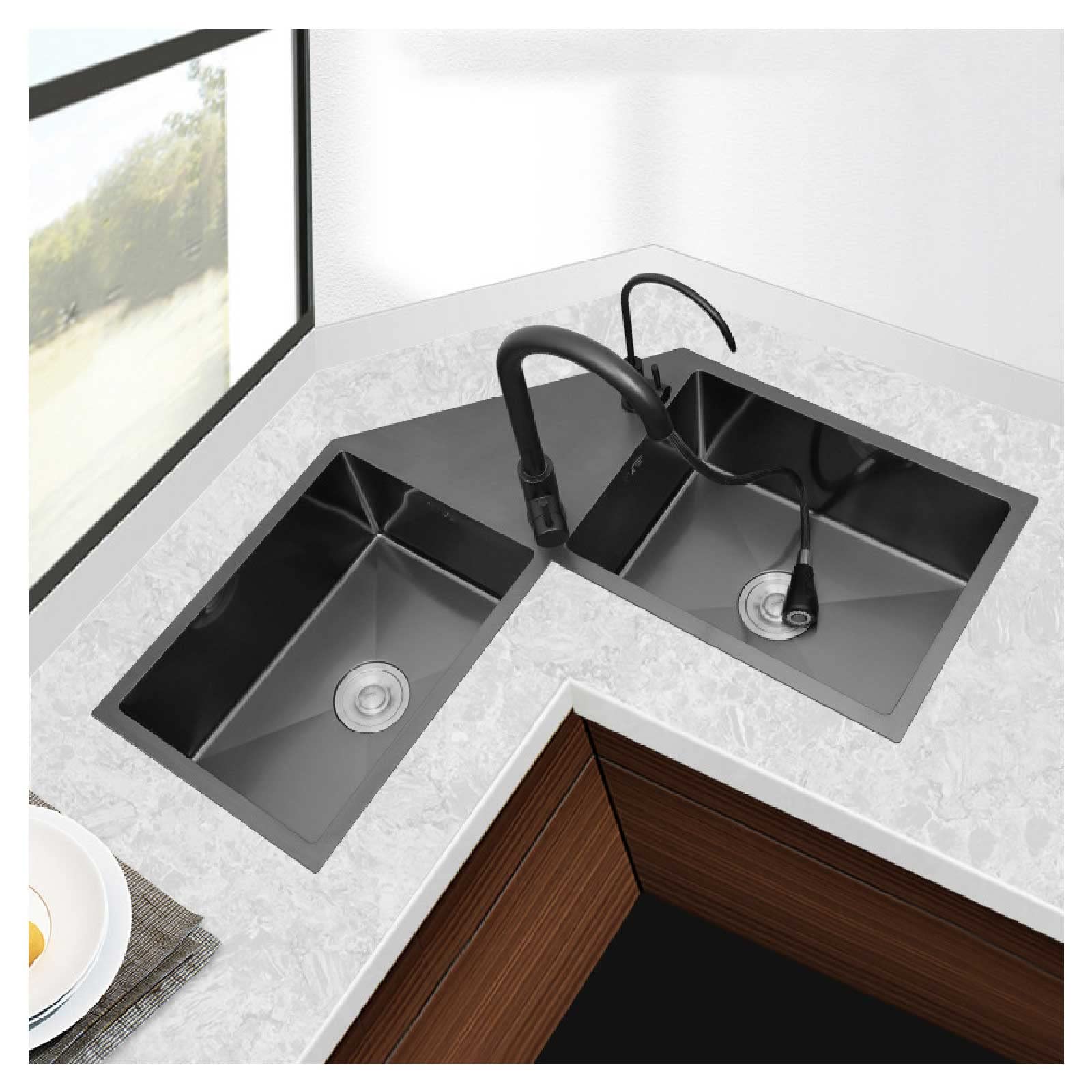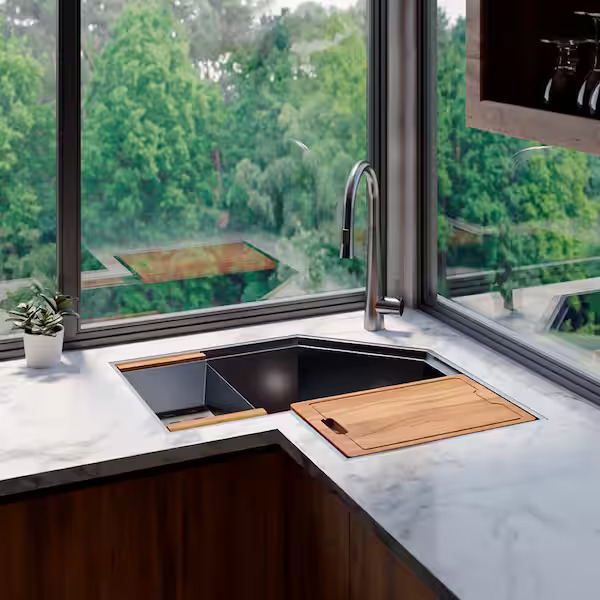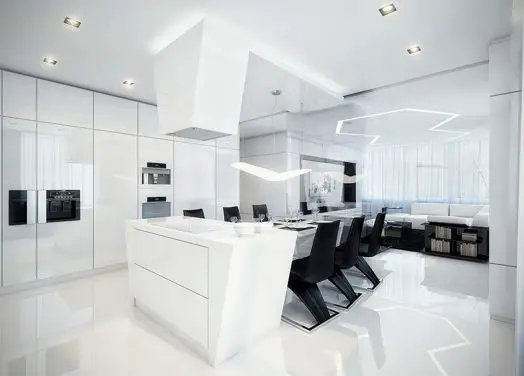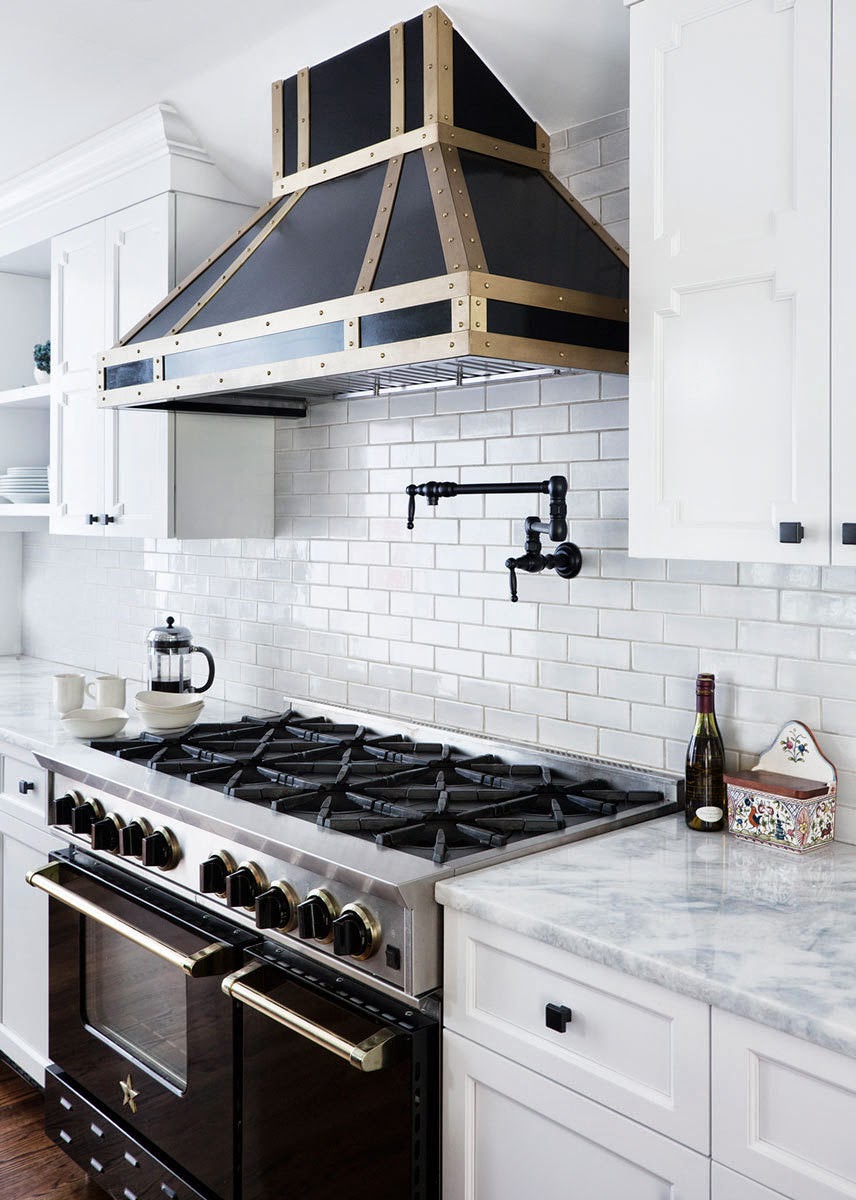In a bustling kitchen, every inch counts. Yet, often, the corners remain underutilized. Enter corner sinks – the unsung heroes of space optimization in kitchens. These clever fixtures not only make use of neglected nooks but also add a touch of functionality and style to your culinary haven.
Traditional sinks may hog precious counter space or obstruct traffic flow, but corner sinks elegantly sidestep these issues. They carve out room for counter space and shelves while creating an efficient work triangle within your kitchen layout. Whether you’re aiming for a cozy cottage vibe or a sleek modern look, corner sinks offer versatility that central counterparts simply can’t match.
Key Takeaways
- Maximize Space: Utilize corner kitchen sinks to efficiently use unused space and create a more functional kitchen layout.
- Evaluate Practicality: Consider the practicality of corner sinks in relation to your specific kitchen layout and workflow to ensure it meets your needs.
- Customize for Your Layout: Customize the corner sink to fit your kitchen layout and enhance its functionality.
- Consider Pros and Cons: Evaluate the pros and cons of installing a corner sink to make an informed decision based on your specific requirements.
- Utilize Vertical Space: Enhance storage and functionality by utilizing vertical space and creative storage solutions around the corner sink area.
- Enhance Aesthetics: Enhance the aesthetics and functionality of the corner sink area with appropriate lighting and accessories.

Evaluating the Practicality of Corner Sinks
Functionality in Small Kitchens
Corner sinks can be a practical solution for maximizing counter space in small kitchens. Placing the sink in a corner frees up more central counter space, providing additional room for food preparation and cooking activities. This arrangement allows for better workflow and movement within the kitchen, making it easier to navigate around when multiple people are working together.
In addition to creating a more efficient workspace, corner sinks also offer increased storage opportunities with shelves and counter. By utilizing the cabinet space underneath and adjacent to the sink, homeowners can optimize their kitchen storage capacity without sacrificing functionality. This is especially beneficial in smaller kitchens where every inch of storage matters.
Another advantage of installing a corner sink is that it provides an opportunity to enhance the overall aesthetic appeal of the kitchen. With various design options available, homeowners have the flexibility to choose a style that complements their kitchen decor while making use of previously unused corners.
Benefits of Utilizing Corner Space
One key benefit of utilizing corner space for sink placement is improved accessibility and ease of use. The strategic positioning allows users to access different parts of the sink from varied angles, making it convenient for multitasking or accommodating multiple users at once.
Moreover, by incorporating a corner sink and shelves, homeowners can create a focal point within their kitchen layout. This not only adds visual interest but also contributes to an efficient work triangle between the stove, refrigerator, and sink, which is essential for optimizing workflow in any kitchen setting.
Furthermore, choosing a corner sink can lead to cost savings as it may eliminate or reduce the need for expensive countertop materials since less linear footage will be required compared to traditional center-placed sinks.
Plumbing and Installation Challenges
While there are numerous benefits associated with corner sinks, it’s important to consider potential challenges related to plumbing and installation. Due to its unique position against two walls rather than one like traditional sinks, proper planning is crucial during installation phase.
Additionally due caution should be exercised when selecting faucets and accessories as they must align with this unconventional setup.
Despite these challenges however many find that investing time into finding solutions pays off given all other benefits mentioned earlier.
Maximizing Space with Corner Kitchen Sinks

Efficient Kitchen Design
Making the most of every inch of space is crucial. Utilizing underutilized corner areas can significantly contribute to an efficient kitchen design. By installing a corner sink, you can make use of the often neglected corners and create a more functional and visually appealing kitchen layout.
Corner sinks are perfect for maximizing countertop space in small kitchens where every inch counts. They free up the central area, allowing for better traffic flow and providing additional workspace along both sides of the sink. This extra countertop space can be utilized for various tasks such as food preparation, placing small appliances, or simply having more room to work comfortably.
Storage Solutions
In addition to creating more countertop space, incorporating storage solutions around corner sinks further optimizes the available space. Installing custom cabinets or open shelves in the adjacent corner spaces not only adds functionality but also enhances the overall aesthetics of the kitchen.
Unique Design Ideas for Corner Kitchen Sinks
Modern and Sleek Designs
Modern and sleek designs can transform the kitchen space. A contemporary stainless steel corner sink with a minimalist faucet can add a touch of elegance to the kitchen. The clean lines and polished finish create a sophisticated look, making it an ideal choice for homeowners looking to integrate modern design elements into their kitchens.
Incorporating custom materials and finishes further enhances the aesthetics of corner sinks. For instance, opting for a custom-made copper corner sink can introduce warmth and character to the kitchen while serving as a focal point. The unique patina that develops over time adds richness to the overall design, creating an inviting atmosphere in the cooking area.
Innovative Shapes and Styles
Exploring innovative shapes and styles opens up endless possibilities for corner sink options. An angular or geometric-shaped sink not only fits perfectly into corners but also introduces an element of visual interest. This unconventional approach challenges traditional design norms, allowing homeowners to create distinctive spaces tailored to their preferences.
Integrating creative features such as built-in cutting boards or multi-level ledges directly into the corner sink design offers practicality without compromising style. These innovative additions maximize functionality while elevating the overall user experience in the kitchen.
Efficient Placement of Corner Sinks and Dishwashers
Convenient Placement
Placing corner sinks in the kitchen can create unused space that often goes unnoticed. However, by strategically positioning dishwashers adjacent to corner sinks, you can make the most of this area. This convenient placement allows for easy access to both the sink and dishwasher, making it a great option for optimizing workflow in the kitchen.
When dirty dishes pile up after a meal, having the dishwasher within arm’s reach of the corner sink makes it easier to transfer them from one appliance to another. This not only saves time but also streamlines the dishwashing process. By coordinating these two essential components of the kitchen layout, you can significantly enhance efficiency and convenience.
Plumbing and Layout Considerations
Coordinating sink and dishwasher placement requires careful consideration of plumbing and layout implications. It’s essential to ensure that both appliances are positioned in a way that facilitates smooth water flow and drainage. Considering how they fit into your overall kitchen design is crucial for achieving a seamless look while maximizing functionality.
The plumbing aspect is critical when planning where to place each component; ensuring proper connectivity ensures efficient operation without any hiccups or potential issues down the line. Moreover, taking into account how this arrangement fits into your kitchen’s layout will help maintain an organized and aesthetically pleasing space.
Customizing Corner Sinks for Your Kitchen Layout
Tailoring Dimensions
When customizing corner sinks for your kitchen, it’s crucial to tailor the dimensions to fit the specific layout. This ensures a seamless integration without any wasted space. For instance, if your corner sink is near a cabinet door, consider the clearance needed for smooth operation. By adjusting the size of the sink and its surrounding countertop space, you can maximize functionality.
Customizing also involves considering the depth and width of the corner sink. If it’s positioned on an angled side of a countertop, ensure that it fits snugly without leaving unused gaps or causing scratches against adjacent surfaces.
Integrating Accessories
Exploring options for integrating accessories and features into custom corner sinks adds both practicality and aesthetics to your kitchen space. For example, incorporating a swivel faucet allows easy maneuvering in confined areas while maximizing use of available water lines.
Installing pull-out trays or cutting board holders within nearby cabinets optimizes storage around the corner sink area. These accessories not only enhance convenience but also make efficient use of otherwise overlooked spaces.
Adapting Design
Adapting the design of corner sinks to complement the overall kitchen style is essential for achieving visual harmony. Whether it’s a farmhouse-style kitchen or a sleek modern design, selecting materials and finishes that align with the existing decor creates a cohesive look.
For instance, opting for stainless steel or granite composite materials might suit contemporary kitchens while porcelain or fireclay could better match traditional ones. The shape and curvature of the sink should also harmonize with other elements in your kitchen such as countertops and cabinetry hardware.
Pros and Cons of Installing a Corner Sink
Maximizing Space
Installing a corner sink offers numerous benefits. By placing the sink in an underutilized area, you can free up more central space for other essential kitchen activities. This layout allows for better traffic flow and creates a more functional workspace, especially in smaller kitchens. Corner sinks can provide a visually appealing focal point that adds character to the kitchen.
Corner sinks also offer increased flexibility when designing the overall layout of your kitchen. They can be paired with clever storage solutions such as rotating shelves or pull-out drawers to optimize every inch of available space. With strategic planning, this type of sink installation can make previously wasted corners useful and efficient.
Limited Cabinet Storage
One potential drawback of installing a corner sink is the impact on cabinet storage. Due to its location, there may be limited cabinet space near the sink area, making it challenging to store larger items or access commonly used utensils easily. However, this limitation can be mitigated by incorporating alternative storage solutions such as open shelving or custom-built cabinets designed specifically for corner spaces.
It’s important to consider how your specific cooking and cleaning habits will interact with the placement of a corner sink within your kitchen layout. While it may require some adjustment in terms of organization and accessibility, creative solutions can help offset any potential loss of cabinet storage near the sink area.
Impact on Overall Functionality
The installation of a corner sink has significant implications for overall kitchen functionality. It affects workflow patterns during meal preparation and cleanup tasks due to its unique placement within the kitchen triangle – which includes the stove, refrigerator, and sink – impacting efficiency while working in the kitchen.
Moreover, if not properly planned out during design and installation phases, positioning a corner sink could lead to challenges related to plumbing configurations or inadequate countertop space around it. However these issues are addressable through thoughtful planning ensuring that both convenience and aesthetics are taken into account when integrating a corner sink into your kitchen design.
Utilizing Vertical Space and Creative Storage Solutions
Maximizing Vertical Space
Maximizing vertical space is crucial. By implementing shelving or hanging storage above the corner sink, you can make use of the often underutilized area. This allows for storing items such as dishware, glasses, or even decorative pieces without taking up valuable counter space. For example, installing open shelves above the sink provides easy access to frequently used items while also creating an opportunity to display stylish kitchenware.
In addition to shelves, utilizing wall-mounted organizers can further optimize vertical space around a corner sink. These organizers offer a convenient way to keep cooking utensils and cleaning supplies within reach yet out of the way. By taking advantage of this unused overhead area, you free up more room on countertops and in cabinets below for other essentials.
Creative Storage Solutions
Incorporating creative storage solutions near the corner sink area is essential for making the most of this part of your kitchen. Pull-out drawers or racks installed beneath the sink provide a practical way to store cleaning supplies or extra dish soap while keeping them easily accessible when needed. This not only maximizes available storage but also ensures that these items are neatly tucked away when not in use.
Moreover, utilizing traditional style racks on either side of the corner sink offers an excellent way to store frequently used cookware or even potted plants if there’s enough natural light from nearby windows. The idea is to capitalize on every inch available by using clever storage options that fit snugly into corners and small spaces.
Optimizing Corner Sink Storage
Making use of creative ways like incorporating pull-out drawers or racks near the corner sink helps optimize its functionality without compromising on aesthetics. Traditional style racks can be utilized effectively inside windows adjacent to your corner sink as they offer great ways not just for displaying pretty dishes but also for storing everyday essentials close at hand.
Enhancing Functionality with Corner Sink Accessories
Practical Cutting Board Inserts
One way to utilize the unused space in a corner sink setup is by exploring practical accessories like cutting board inserts. These specialized inserts are designed to fit perfectly into the sink basin, providing an instant and convenient workspace for food preparation. By incorporating a cutting board insert, you can effectively create a dedicated area for chopping, slicing, and dicing right at your corner sink. This not only optimizes the available space but also enhances the overall functionality of your kitchen.
Another benefit of these cutting board inserts is their ability to maximize accessibility. With this addition, you can easily access your cutting board without having to reach across the counter or walk back and forth between different areas of the kitchen. It streamlines meal preparation by keeping all necessary tools within arm’s reach, making cooking more efficient and enjoyable.
Specialized Faucets and Sprayers
Incorporating specialized faucets and sprayers is another effective way to enhance functionality in a corner sink setup. These fixtures are specifically designed to optimize usage in tight spaces such as corner sinks. By installing a faucet with an extendable neck or adjustable features, you can ensure that every part of the sink basin is easily accessible for cleaning various items.
Utilizing a specialized sprayer attachment can significantly improve cleaning efficiency in a corner sink arrangement. The flexibility and extended reach provided by these sprayers make it easier to clean larger pots, pans, or other bulky items that may be challenging to maneuver within standard sink configurations.
Custom Grids and Strainers
To further optimize the efficiency of a corner sink, consider using custom grids and strainers tailored for this specific layout. These accessories help prevent debris from clogging up your drain while also protecting delicate dishes during washing. Custom grids are designed to fit perfectly into the bottom of the sink basin, providing stability for fragile items while allowing water to flow freely underneath.
Similarly, specialized strainers crafted for corner sinks offer enhanced protection against blockages by effectively trapping food particles without obstructing water drainage. By incorporating these custom accessories into your corner sink setup, you can maintain cleanliness while prolonging the lifespan of your plumbing system.
Lighting and Aesthetics for Corner Kitchen Sinks
Strategic Lighting Fixtures
Enhancing the functionality of corner sinks can be achieved through strategic lighting fixtures. Placing under-cabinet lights or overhead pendant lights can effectively illuminate the area around a corner sink, making it more functional and visually appealing. By strategically positioning these lighting fixtures, you can ensure that every nook and cranny of the corner sink area is well-lit, providing better visibility for various kitchen tasks.
Strategic lighting not only brightens up the space but also creates a welcoming ambiance in the kitchen. It can transform a dimly lit corner into an inviting focal point, drawing attention to the unique placement of the sink while making it easier to use during all times of day.
Decorative Backsplashes
Selecting aesthetic elements such as decorative backsplashes is another way to enhance the visual appeal of a corner sink. Installing an eye-catching backsplash behind and around the sink area adds personality and style to this often overlooked part of the kitchen. Utilizing colorful tiles, intricate patterns, or textured materials on the backsplash can turn it into a stunning focal point within your kitchen design.
A decorative backsplash not only beautifies your kitchen space but also serves a practical purpose by protecting your walls from water damage and stains caused by daily use of the sink. It’s an opportunity to infuse creativity into your kitchen decor while ensuring that this frequently used area remains easy to maintain.
Complementary Design Elements
Incorporating complementary design elements is essential when integrating a corner sink seamlessly into your overall kitchen aesthetic. This involves carefully selecting cabinet styles, countertop materials, and faucet designs that harmonize with both the corner sink’s form and function as well as with other elements in your kitchen.
For instance, choosing cabinets with custom storage solutions optimized for corner spaces maximizes utility without compromising aesthetics. Similarly, coordinating countertop materials that complement both the color scheme and texture of your chosen corner sink enhances visual continuity throughout your culinary workspace.
Closing Thoughts
You’ve explored the practicality, space-saving potential, design ideas, placement efficiency, customization options, and the pros and cons of corner kitchen sinks. By optimizing vertical space, incorporating creative storage solutions, and enhancing functionality with accessories and suitable lighting, you can truly elevate the aesthetics and functionality of your kitchen. Whether you’re aiming for a modern, sleek look or a cozy, farmhouse vibe, corner sinks offer versatility that can be tailored to your unique style and needs. Now it’s time to put these insights into action and transform your kitchen with a well-placed and thoughtfully designed corner sink that maximizes both space and visual appeal.
So go ahead, unleash your creativity and make the most of that unused kitchen corner! Your culinary haven awaits.
Frequently Asked Questions
Are corner sinks practical for small kitchens?
Corner sinks are highly practical for small kitchens as they maximize unused space and create a more efficient workflow. Their unique placement allows for better utilization of the surrounding countertop areas, making them a valuable addition to compact kitchen layouts.
What are the pros and cons of installing a corner sink?
The pros of installing a corner sink include maximizing space, enhancing functionality, and adding visual interest to the kitchen. However, potential cons may involve limited cabinet storage underneath and challenging installation processes due to their non-standard shape.
How can I customize a corner sink to fit my kitchen layout?
Customizing a corner sink involves selecting the right size, depth, and material that complements your kitchen’s design. You can explore various faucet styles and accessories to enhance both the aesthetics and functionality of your unique corner sink setup.
Can vertical space be effectively utilized with corner sinks?
Absolutely! Vertical space above or around corner sinks can be optimized through creative storage solutions such as open shelving or hanging racks. This helps in keeping frequently used items within easy reach while maintaining an organized and visually appealing kitchen environment.
What lighting options work best for showcasing a corner sink area?
Consider incorporating under-cabinet lights or overhead pendant fixtures to illuminate this focal point effectively. These options not only provide functional task lighting but also contribute to enhancing the overall aesthetics of your kitchen design.






